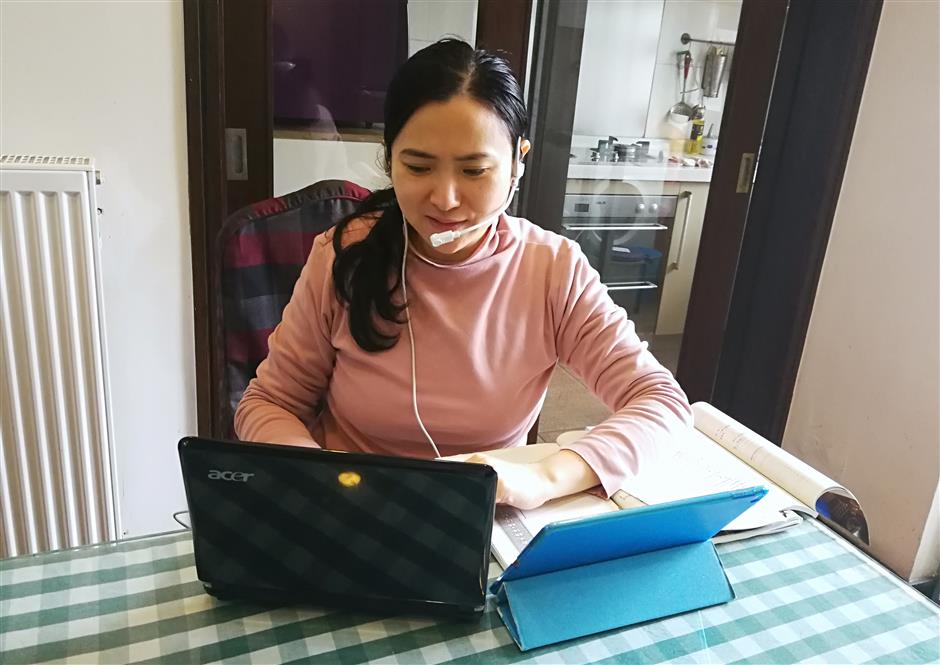Trials, tribulations of online teaching during epidemic
Online courses are a great alternative to keep students engaged in quality learning at home with teachers during the epidemic period. For most teachers, it’s a relatively new way to deliver lessons but a challenge they’ve accepted and adapted to.
Chinese and politics teacher Guan Xindie, 31, who teaches at a Baoshan District primary school, admitted teachers and pupils in her school had undergone several “trial and error lessons” before an official class was launched on March 2.
The Shanghai Education Commission revealed that about 1,000 sessions had been recorded for broadcast on TV and Internet platforms for local primary and secondary students, with each session lasting around 20 minutes. At the same time, about 120,000 school teachers took part in after-class discussions with the students for another 20 minutes.

A student corrects his homework according to the feedback from his teacher on the iPad.
An English teacher called J was one of them.
“I’m always afraid that what I have prepared is not consistent with the lessons taught on TV,” said J from a primary school in Minhang District. “Usually in a classroom situation, it doesn’t need to be so consistent with the order of a textbook. It can be taught in line with different teachers.
“It’s also my first time to watch what is being taught in a set model. Thus, I need to adjust my teaching materials in 20 minutes and start my online discussion afterward.”
Guan said she would condense her regular 35-minute class into a 20-minute one, picking out the important and difficult points and making some new slides specifically for online teaching. Guan has eight lessons every week, six Chinese and two politics.
“I used to finish work at 4pm, but now I work till 10:30pm. I am not complaining, but it will certainly take more time, more testing and more effort,” she said.

Guan Xindie now offers eight online lessons every week at home.
Every day students take photos of their finished homework and send them online to teachers, sometimes with the help of parents. It’s a common way for most students to hand in homework during this period.
“At school, I correct their paper homework immediately. And, if necessary, pupils get direct feedback on their work,” Guan said.
Now Guan checks homework on an iPad. But she doesn’t believe remote teaching is as efficient as working in the classroom at school because homework can be sent back and forth four to five times between the teacher and her pupils before it is correct.
Liang Yuzhi, a Chinese teacher in Shanghai Foreign Language School, also shared her concerns.
“What I am concerned about most is the devices and environment, such as enough network flow and the stability of the Internet at my place,” she said.
“I have lessons for two classes. When they are done, I have to check 90 digital versions of compositions and test papers, which do much more harm to my eyesight. What’s more, it’s hard to check some oral homework, such as reciting and dictation.”
Liang said she is still trying to find different ways to resolve the problems.
Self-discipline is important
Although many teachers have experienced some hardships through online teaching, there have been several positive aspects of teaching on the platform.
“At lease the network enables us to continue teaching and learning during this unique period,” said Guan, who teaches a class of 40 pupils.
She regards online learning as a “monster-revealing mirror,” which will distinguish students with good self-discipline from those without discipline.
Dian, who teaches physics in a middle school in Baoshan, agreed with her.
“Online learning mainly depends on students’ self-awareness,” Dian said.
Liang also gave a thumbs up to the Shanghai government and education commission for all of their hard work during the epidemic.
“It’s forward-looking of them to program recorded courses and launch online classes on time,” said the Chinese teacher. “They are demo classes with high quality.”

Liang Yuzhi, a Chinese teacher with the Shanghai Foreign Language School, gives her lessons at home, using a laptop and an iPad at the same time.
One of the negatives about online teaching is getting pupils to sit still in front of a video camera.
“Many students were too shy to open their cameras at first,” said Liang, who admitted she misses the banter and laughter of her classroom when a good joke is told. “Thus, we lack mutual consent and instant communication, which we have in a class setting.”
Many teachers believe AI will replace several occupations in the future but not that of the teaching profession.
Teachers believe they will escape AI because teaching is a job of communicating, face to face and in an intimate way.
The nation’s teachers are doing a superb job in difficult circumstances. But most will sympathize with J’s feelings and thoughts when she said, “I’m looking forward to my school opening and seeing my students again. I miss them.”

















